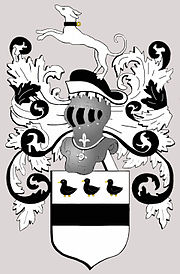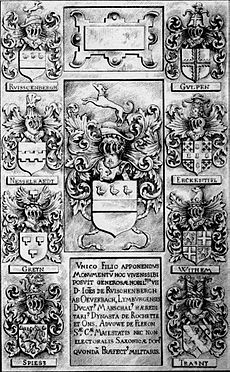Johann von Reuschenberg zu Overbach
Johann von Reuschenberg zu Overbach and Rochette (* 1554 - 18 January 1638 ) was imperial colonel, Jülischer councilor, bailiff of Jülich , hereditary marshal of the Duke of Limburg , hereditary bailiff of the glory Fléron and, from 1623, imperial and electoral Saxon court master. His first marriage was to Margarethe von Loë , who died on September 26, 1600. After her death, he married Sibylle Maria von Plettenberg in 1602 , with whom he had two children. His 18-year-old son Edmund died on May 13, 1623. His daughter Constance was married to Jodocus von Kerckhoven.
Life
Johann von Reuschenberg was the second eldest son of Wilhelm and Margarethe von Gülpen and thus belonged to a branch line of the noble von Reuschenberg family . Philippine and Anna von Reuschenberg were also among his siblings . One of his uncles was the Teutonic Knight Heinrich von Reuschenberg zu Setterich .
After the death of his father around 1586, he inherited the titles of his father in addition to various estates and thus became Hereditary Marshal of the Duchy of Limburg and Hereditary Bailiff to Fléron (east of Liège ).
At this point in time he was probably already a Jülich cavalry officer. Reuschenberg belonged to a circle of Catholic councilors who took advantage of the mental illness of Duke Johann Wilhelm von Jülich to take over the business of government. The Duke's first wife, Jakobe von Baden-Baden , tried in vain to restrict the power of the councils. She became involved in intrigues and was charged by her sister-in-law Sibylle in 1595 . The lieutenant-colonel Reuschenberg moved at this time with the regiment Schwarzenberg to Hungary against the Turks to fight. He was ordered back to Düsseldorf by a courier to testify as a witness for the Duchess Sibylle. Jakobe died two years later under unknown circumstances.
In 1600, with the help of Antonie von Lothringen , the Duke's second wife, he became bailiff of the fortress town of Jülich. It played a role in the Aachen religious unrest insofar as it permanently disrupted trade among Aacheners. Among other things, it was his mercenaries who repeatedly attacked the villages, individual farms and copper mills belonging to Aachen . The Aachen council then sued the duke and his consorts before the Reich Chamber of Commerce in Speyer and before the Imperial Councilor in Vienna.
After the death of his mother in 1603, he inherited the castle and lands of Rochette (located near Chaudfontaine ). He also became the owner of a mine in which galena and pyrites were extracted.
After the duke died childless in 1609, a national crisis broke out. Two competing candidates for the successor, the Protestant princes Johann Sigismund von Brandenburg and Wolfgang Wilhelm von Pfalz-Neuburg , allied themselves in order to better enforce their demands against the Emperor Rudolf II . The latter had already awarded the duchy of Electoral Saxony and now sent Archduke Leopold V to Düsseldorf as his principal commissioner and commander in order to enforce his claims. Even before Leopold V's arrival, however, the political situation there got out of control, at least from a Catholic perspective.
The Catholic councilors were detained in the city, and Reuschenberg - now with the rank of colonel - narrowly escaped its arrest. He withdrew to Jülich and prevented the Protestant princes from entering their troops. In this way he turned the fortress town into an outpost of the Catholic Habsburgs . An alliance of German, Dutch and French troops as well as English and Scottish units then besieged the fortress from July 29, 1610 under the command of Moritz von Orange . In order to be able to pay his troops even more, Reuschenberg had Archduke Leopold V's silverware cut up and stamped. The emergency coins from 1610 all have an oval stamp with two letters: an R (for Emperor Rudolf II.) With a crown over it and an L (for Archduke Leopold V). In addition, a number to indicate the value.
Reuschenberg stubbornly defended Jülich, but since powder and food were running out and relief troops were not to be expected, he finally had to give up. He accepted the terms of surrender and handed over the fortress on September 2nd (the picture shows him handing over the fortress city to the commanders of the Alliance with a bow - see letter A ). Trying to secure Jülich for the Kaiser was a very risky undertaking. It provoked an armed conflict on a European level and almost - eight years before the start of the Thirty Years' War - set the German Reich on fire.
After the handover, he and his units moved to the Strasbourg area to unite with the troops of Archduke Leopold V. His job was to recruit more troops. By March 1611, Reuschenberg was able to recruit 15 flags . However, he apparently lacked the means to pay the wages, because he was in the meantime placed under arrest by his own people. In the years that followed, Reuschenberg did not only operate in Alsace . In 1613 he was one of the 20 officials and dignitaries (including Ferdinand of Bavaria ) who represented Kurköln at the Regensburg Reichstag. There is also evidence that he traveled to the Electoral Court via Prague in Dresden. He also stayed in Rochette again and again. In 1619 - one year after the beginning of the Thirty Years' War - Colonel Reuschenberg was granted a patent to form the Imperial Ruischenberg Foot Regiment from five flags . This regiment is not to be confused with the Ruischenberg regiment (formerly Anholt regiment, later Geleen regiment), which was only named after Colonel Johannes Ernst von Reuschenberg zu Setterich in 1635 . During the Great War there were therefore two colonels named Johann von Reuschenberg. In the older literature, there was therefore some confusion.
Reuschenberg spent his last years at Rochette Castle and in 1628 declared in an order that his wife was allowed to use all his goods for life. These were the house and the glory Rochette, Olne with the Bailiwick of Fléron, House Overbach , House Holtrop with the associated farms, inheritance and goods in the country of Brabant , country Luxembourg, Liège monastery , Principality of Jülich and the archbishopric of Cologne . Johann von Reuschenberg died in 1638. Like his son before that, he was buried in the Jesuit church of St. Catherine in Liège (today St. Antoine and St. Catherine). His well-preserved epitaph can still be found there today.
See also
literature
- Bernd Reuschenberg: Johann von Reuschenberg zu Overbach and Roschette (1554–1638)] (Part I). In: Communications of the Baesweiler History Association. No. 46/2013, pp. 12-14.
- Bernd Reuschenberg: Johann von Reuschenberg zu Overbach and Roschette (1554–1638)] (Part II). In: Communications of the Baesweiler History Association. No. 47/2014, pp. 6-8.
- Herbert M. Schleicher (Ed.): Ernst von Oidtman and his genealogical-heraldic collection in the University Library in Cologne . Volume 12, Cologne 1997.
- Bulletin de la Société d'art et d'Histoire du Diocèse de Liège. Volume 7, Liège 1892.
- C. Schaumburg: General Wilhelm von Calckum, called Lohhausen, a Bergisch warrior. In: Journal of the Bergisches Geschichtsverein. Volume 3, Bonn 1866.
Web links
Individual evidence
- ^ Ernst von Oidtman and his genealogical-heraldic collection in the University Library in Cologne, ed. v. Herbert M. Schleicher, Volume 12, Cologne 1997, p. 701.
- ↑ Bernd Reuschenberg: Johann von Reuschenberg zu Overbach and Roschette (1554–1638) (Part I). In: Communications of the Baesweiler History Association. No. 46/2013, p. 12.
- ↑ Bernd Reuschenberg: Johann von Reuschenberg zu Overbach and Roschette (1554–1638) (Part II). In: Communications of the Baesweiler History Association. No. 47/2014, p. 6.
- ↑ Geographische Zeitung der Hertha, magazine for geography, ethnology and national studies. With the participation of Baron Alexander von Humboldt, ed. v. Heinrich Berghaus and Karl Friedrich Hoffmann, Volume 8, Stuttgart / Tübingen 1826, p. 303.
- ↑ Beer von Laar: Original memorabilia of a contemporary at the court of Johann Wilhelm III., Duke of Jülich-Cleve-Berg. Ed. V. E. Kühlwetter and F. Custodis, Düsseldorf 1834, p. 7 f.
- ↑ Koehler, Johann David: Johann David Koehler's PP in the year 1733 weekly published historical coin amusements, fifth part, therein all kinds of remarkable and rare thalers / ducats / show pieces and other strange gold and silver coins, Nuremberg 1733, p. 169.
- ^ Report on the Manuscripts of the Marquess of Downshire. Volume 3: Papers of William Trumbull the elder 1611-1612. Ed. V. EK Purnell and AB Hinds, London 1938, pp. 20 and 39.
- ^ Edith Ennen: History of the city of Bonn. Part II, Bonn 1962, p. 114 f.
- ^ Letters and files on the history of the Thirty Years' War in the time of the predominant influence of the Wittelsbachers (1598–1618). Volume 8: From the armaments of Duke Maximilian of Bavaria to the departure of the Passau people. Ed. V. Felix Stieve, arr. v. Karl Mayr, Munich 1908, p. 699.
- ↑ Inventories of non-governmental archives: Inventory of the document archive of the princes of Hatzfeldt-Wildenburg zu Schönstein / Sieg, Volume 5, Regesten No. 2251 to 3507, 1607-1852, revised. v. Jobst Kloft, Koblenz 1988, p. 76.
| personal data | |
|---|---|
| SURNAME | Reuschenberg zu Overbach, Johann von |
| BRIEF DESCRIPTION | Jülischer Rat, bailiff zu Jülich, hereditary marshal of the Duke of Limburg, hereditary bailiff of the glory Fléron, imperial and electoral Saxon chief steward |
| DATE OF BIRTH | 1554 |
| DATE OF DEATH | January 18, 1638 |



